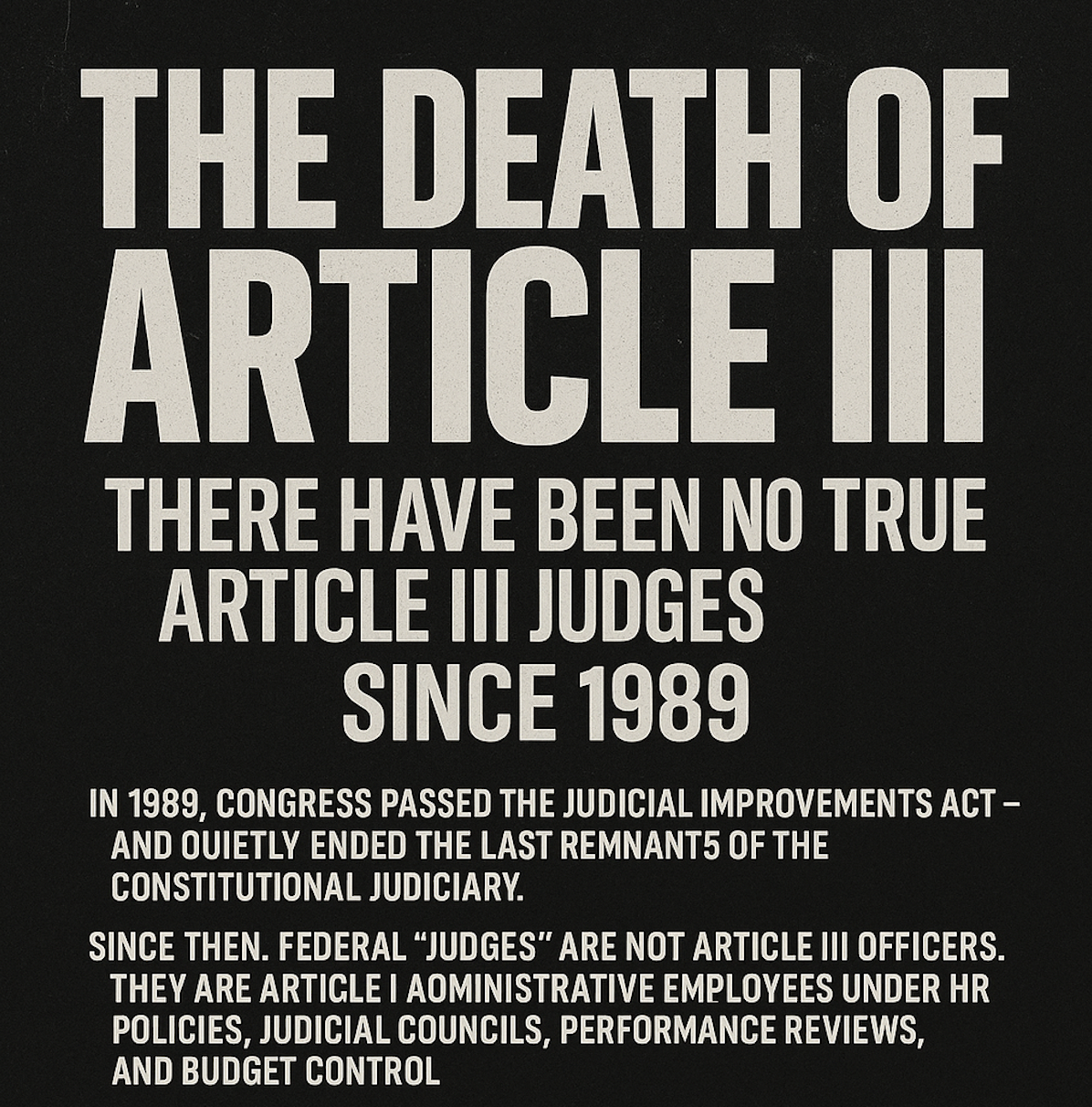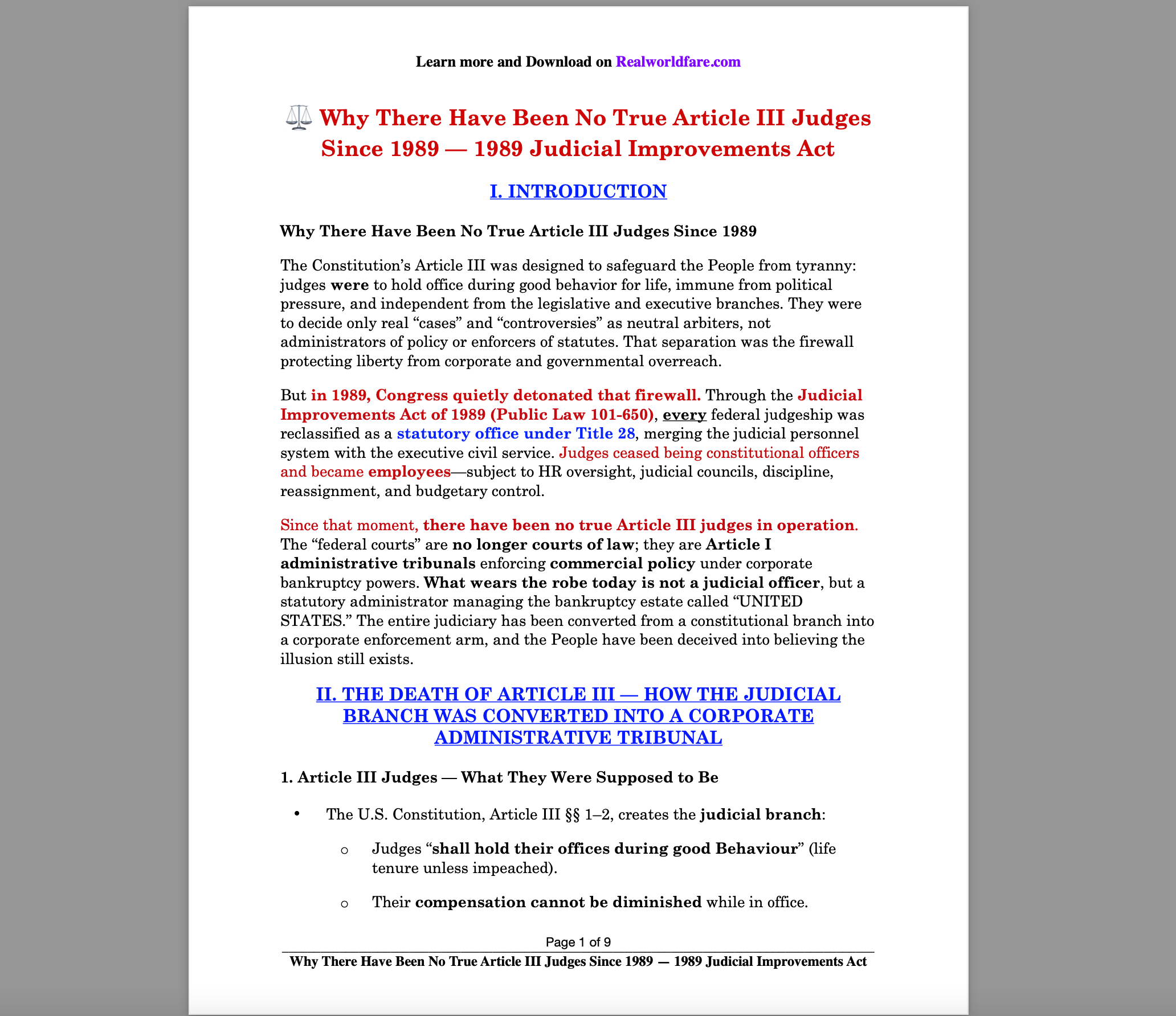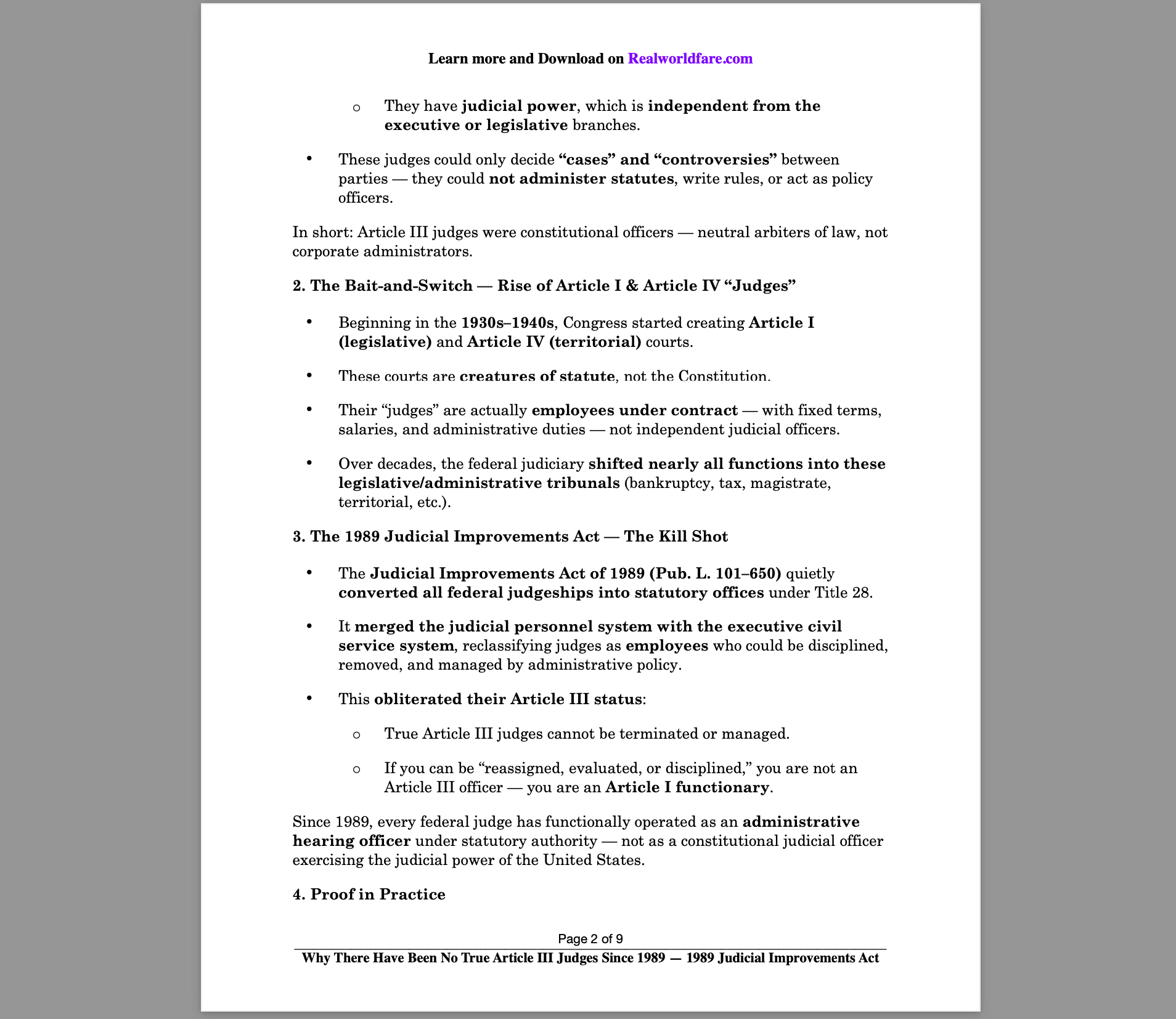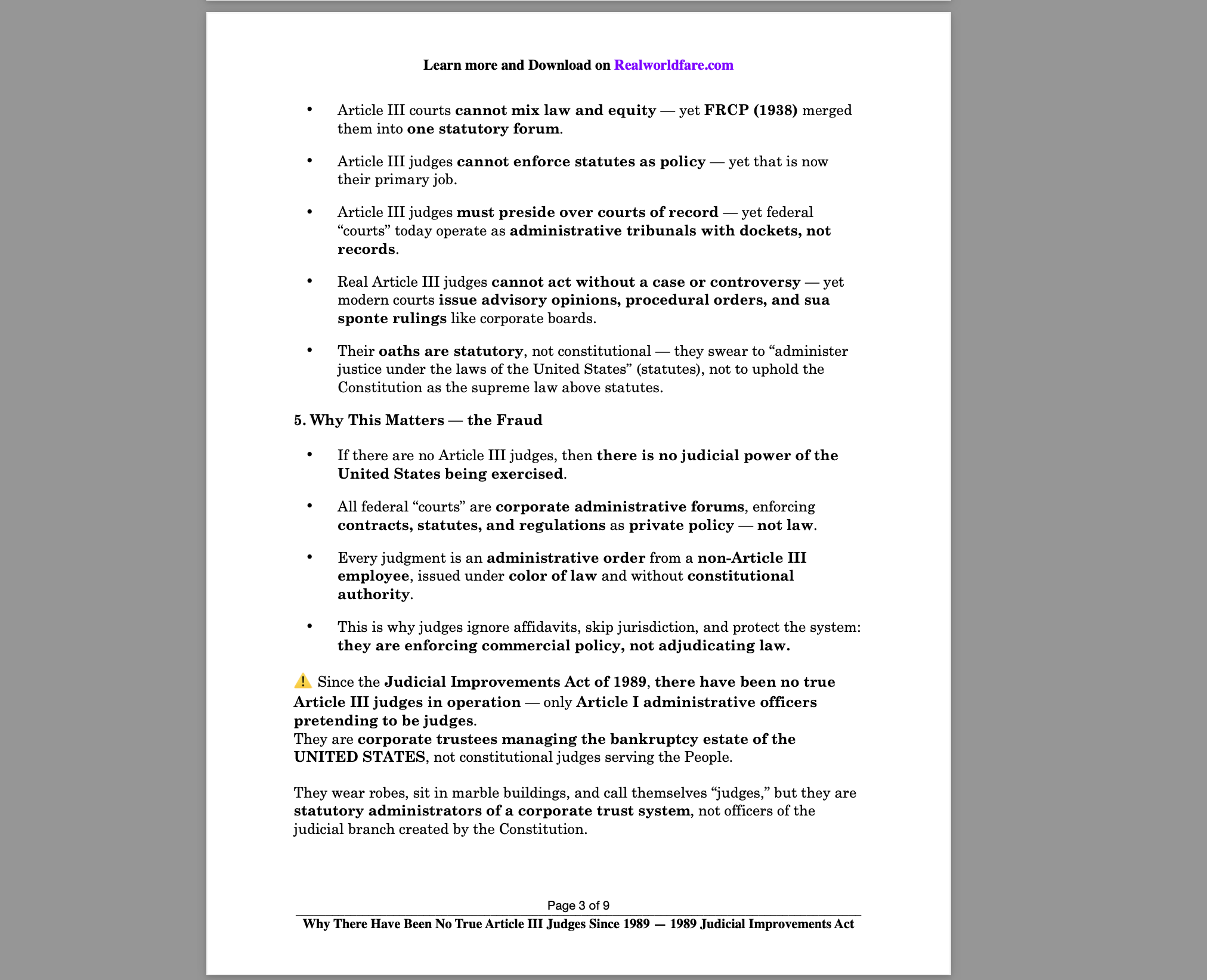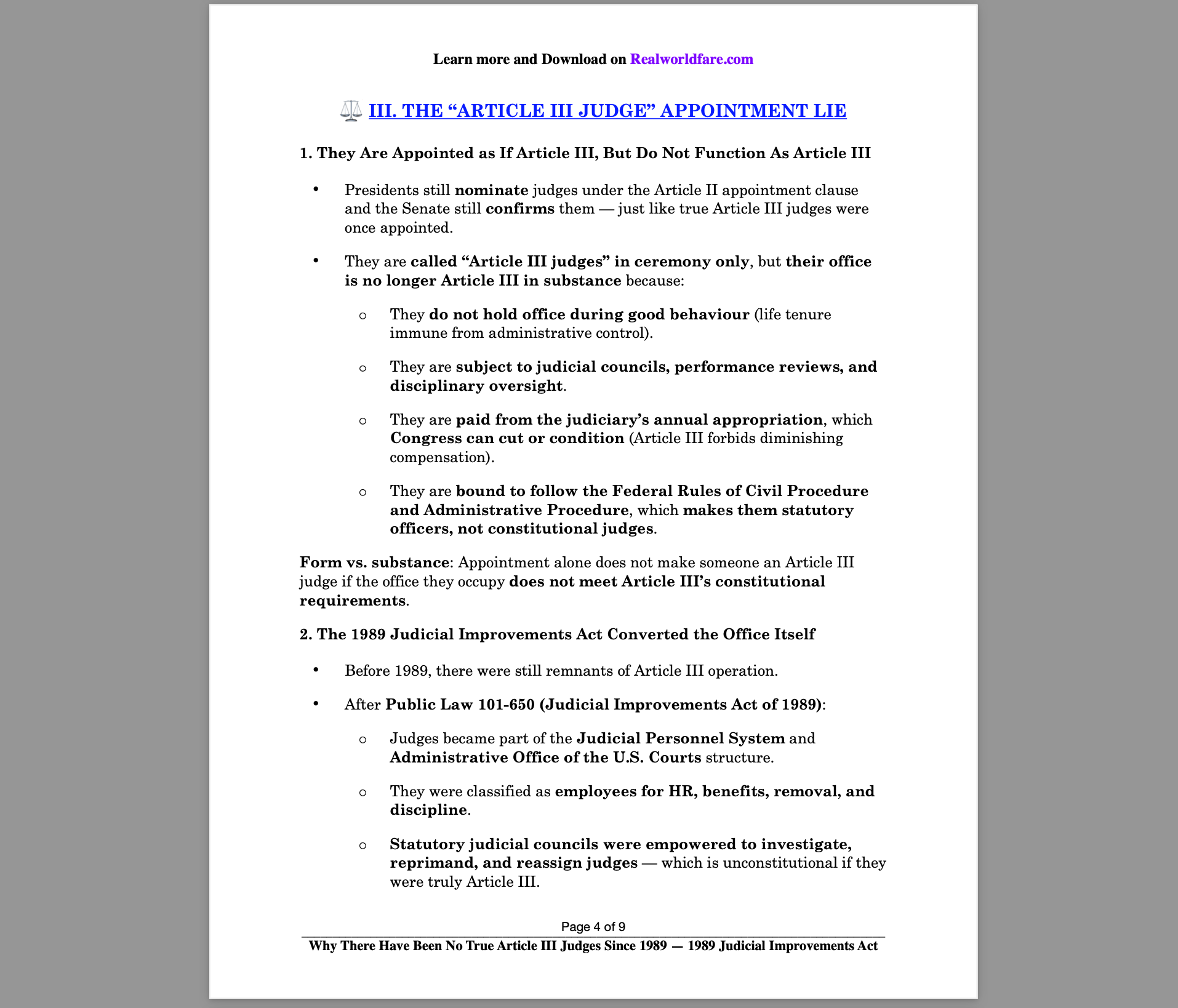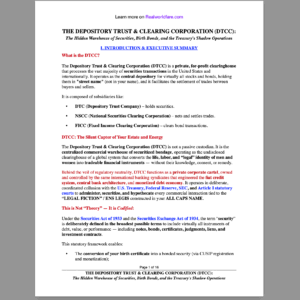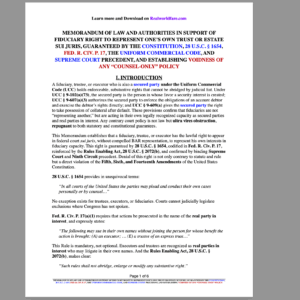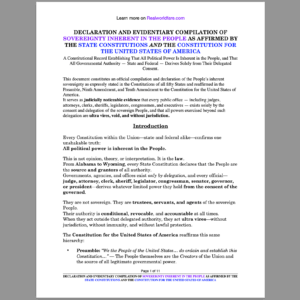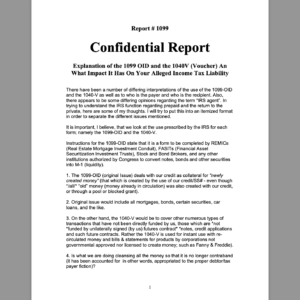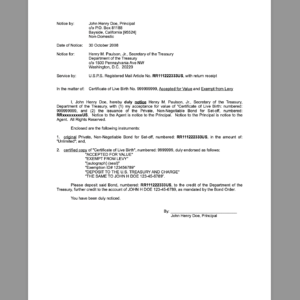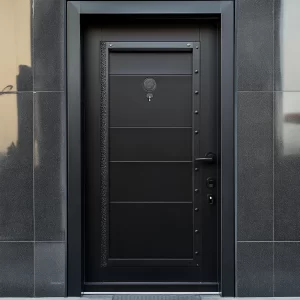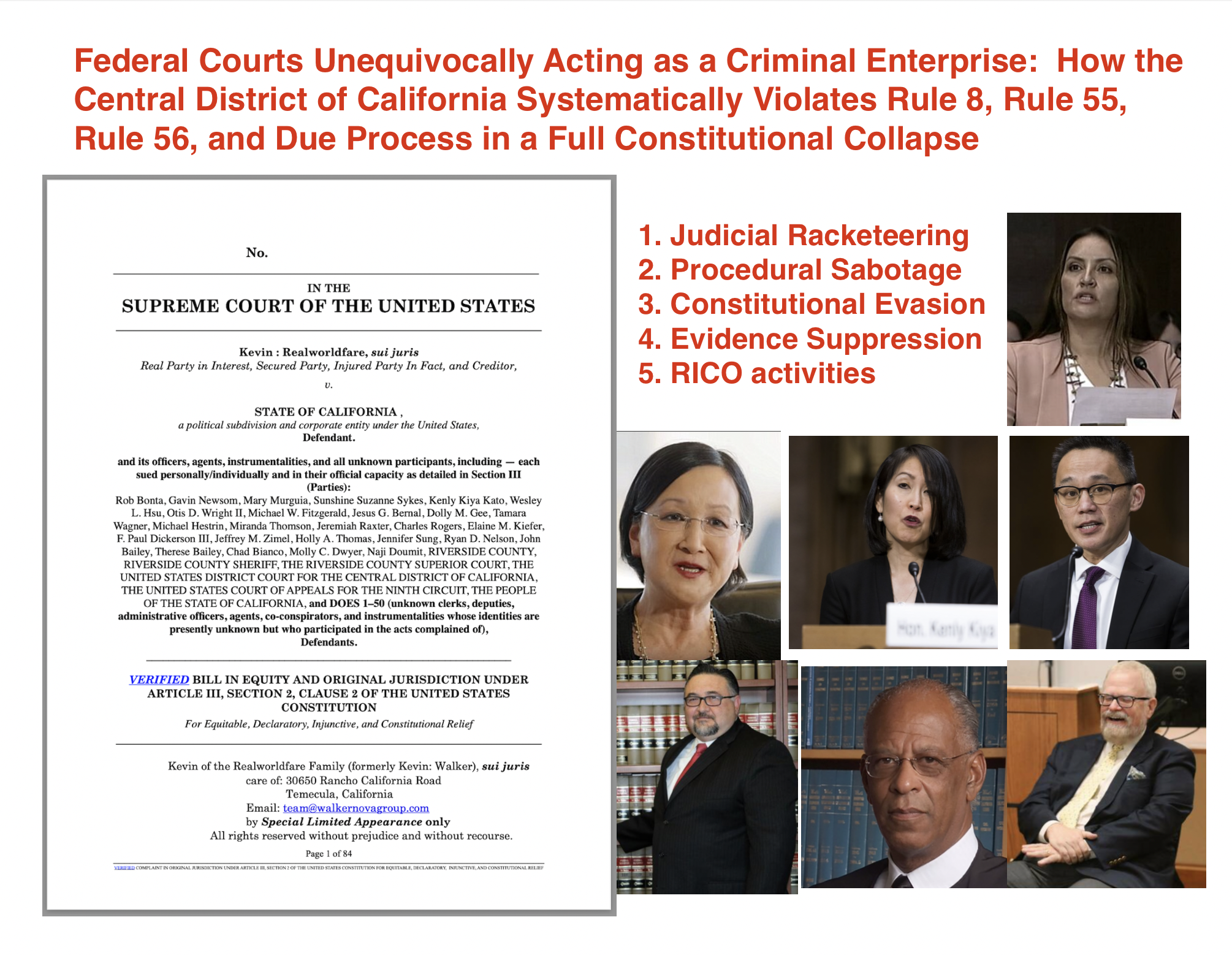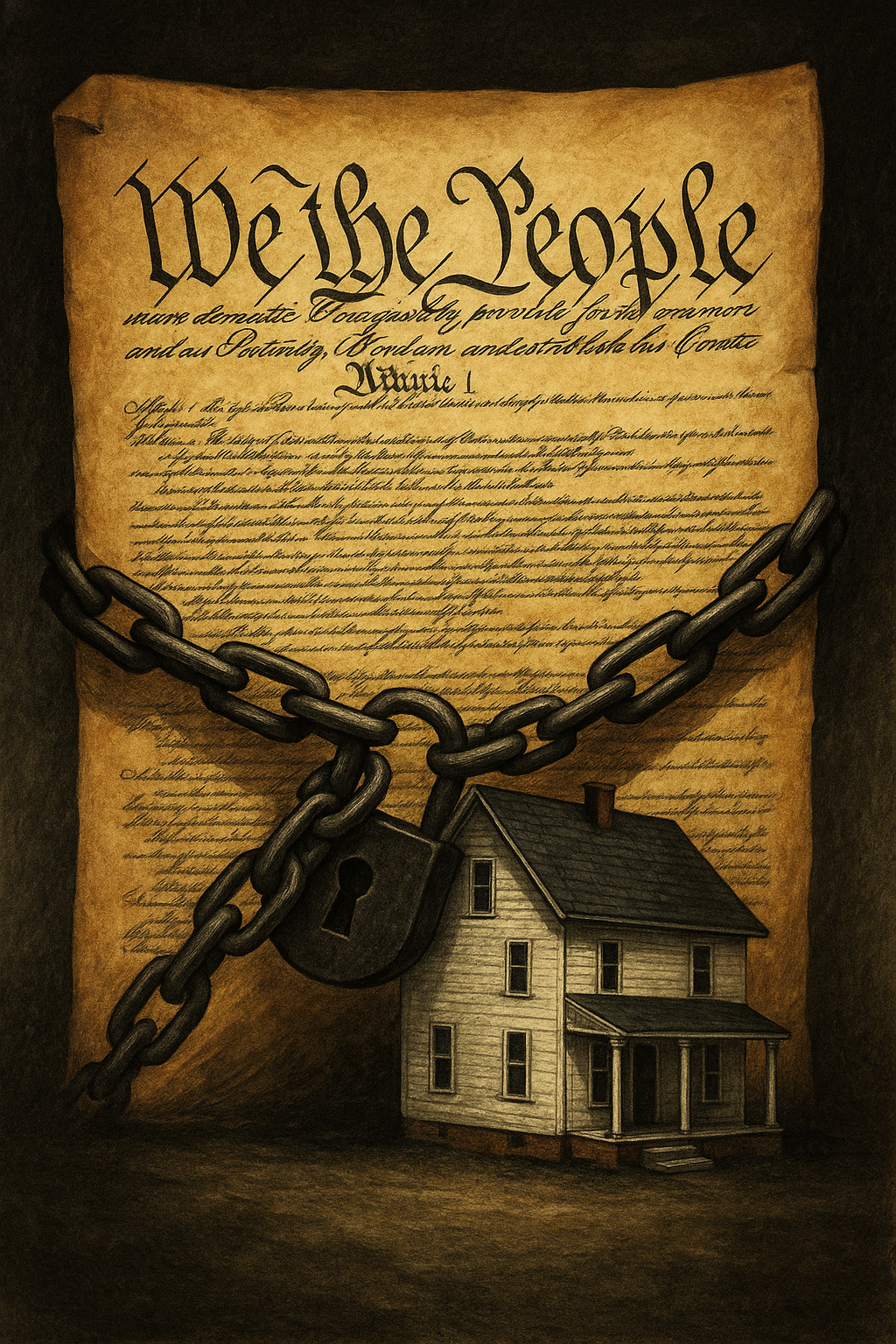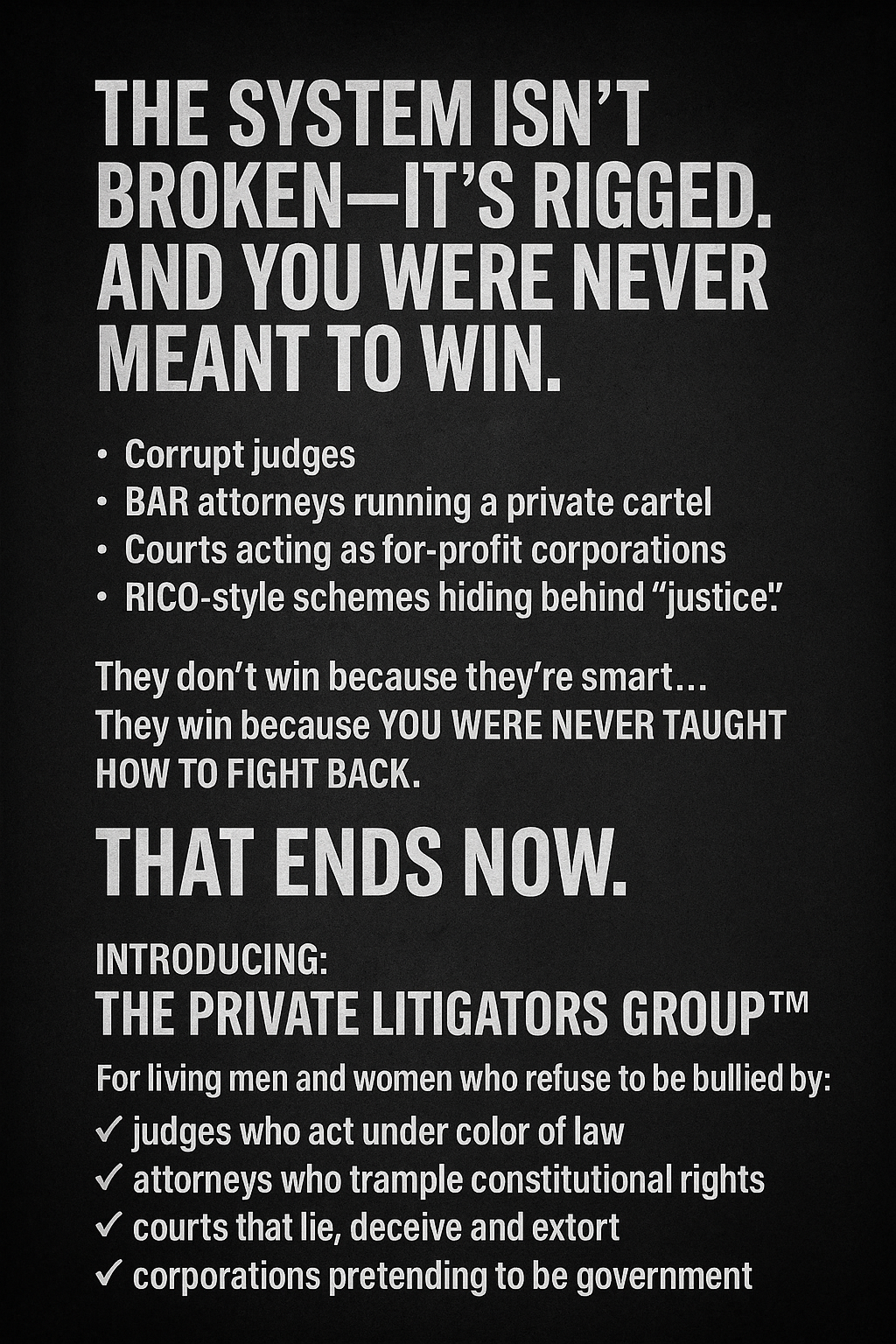I. Introduction
Why There Have Been No True Article III Judges Since 1989
The Constitution’s Article III was designed to safeguard the People from tyranny: judges were to hold office during good behavior for life, immune from political pressure, and independent from the legislative and executive branches. They were to decide only real “cases” and “controversies” as neutral arbiters, not administrators of policy or enforcers of statutes. That separation was the firewall protecting liberty from corporate and governmental overreach.
But in 1989, Congress quietly detonated that firewall. Through the Judicial Improvements Act of 1989 (Public Law 101-650), every federal judgeship was reclassified as a statutory office under Title 28, merging the judicial personnel system with the executive civil service. Judges ceased being constitutional officers and became employees—subject to HR oversight, judicial councils, discipline, reassignment, and budgetary control.
Since that moment, there have been no true Article III judges in operation. The “federal courts” are no longer courts of law; they are Article I administrative tribunals enforcing commercial policy under corporate bankruptcy powers. What wears the robe today is not a judicial officer, but a statutory administrator managing the bankruptcy estate called “UNITED STATES.” The entire judiciary has been converted from a constitutional branch into a corporate enforcement arm, and the People have been deceived into believing the illusion still exists.
II. The Death of Article III — How the Judicial Branch Was Converted into a Corporate Administrative Tribunal
1. Article III Judges — What They Were Supposed to Be
- The U.S. Constitution, Article III §§ 1–2, creates the judicial branch:
- Judges “shall hold their offices during good Behaviour” (life tenure unless impeached).
- Their compensation cannot be diminished while in office.
- They have judicial power, which is independent from the executive or legislative branches.
- These judges could only decide “cases” and “controversies” between parties — they could not administer statutes, write rules, or act as policy officers.
In short: Article III judges were constitutional officers — neutral arbiters of law, not corporate administrators.
2. The Bait-and-Switch — Rise of Article I & Article IV “Judges”
- Beginning in the 1930s–1940s, Congress started creating Article I (legislative) and Article IV (territorial) courts.
- These courts are creatures of statute, not the Constitution.
- Their “judges” are actually employees under contract — with fixed terms, salaries, and administrative duties — not independent judicial officers.
- Over decades, the federal judiciary shifted nearly all functions into these legislative/administrative tribunals (bankruptcy, tax, magistrate, territorial, etc.).
3. The 1989 Judicial Improvements Act — The Kill Shot
- The Judicial Improvements Act of 1989 (Pub. L. 101–650) quietly converted all federal judgeships into statutory offices under Title 28.
- It merged the judicial personnel system with the executive civil service system, reclassifying judges as employees who could be disciplined, removed, and managed by administrative policy.
- This obliterated their Article III status:
- True Article III judges cannot be terminated or managed.
- If you can be “reassigned, evaluated, or disciplined,” you are not an Article III officer — you are an Article I functionary.
Since 1989, every federal judge has functionally operated as an administrative hearing officer under statutory authority — not as a constitutional judicial officer exercising the judicial power of the United States.
4. Proof in Practice
- Article III courts cannot mix law and equity — yet FRCP (1938) merged them into one statutory forum.
- Article III judges cannot enforce statutes as policy — yet that is now their primary job.
- Article III judges must preside over courts of record — yet federal “courts” today operate as administrative tribunals with dockets, not records.
- Real Article III judges cannot act without a case or controversy — yet modern courts issue advisory opinions, procedural orders, and sua sponte rulings like corporate boards.
- Their oaths are statutory, not constitutional — they swear to “administer justice under the laws of the United States” (statutes), not to uphold the Constitution as the supreme law above statutes.
5. Why This Matters — the Fraud
- If there are no Article III judges, then there is no judicial power of the United States being exercised.
- All federal “courts” are corporate administrative forums, enforcing contracts, statutes, and regulations as private policy — not law.
- Every judgment is an administrative order from a non-Article III employee, issued under color of law and without constitutional authority.
- This is why judges ignore affidavits, skip jurisdiction, and protect the system: they are enforcing commercial policy, not adjudicating law.
⚠️ Since the Judicial Improvements Act of 1989, there have been no true Article III judges in operation — only Article I administrative officers pretending to be judges.
They are corporate trustees managing the bankruptcy estate of the UNITED STATES, not constitutional judges serving the People.
They wear robes, sit in marble buildings, and call themselves “judges,” but they are statutory administrators of a corporate trust system, not officers of the judicial branch created by the Constitution.
⚖️ III. The “Article III Judge” Appointment Lie
1. They Are Appointed as If Article III, But Do Not Function As Article III
- Presidents still nominate judges under the Article II appointment clause and the Senate still confirms them — just like true Article III judges were once appointed.
- They are called “Article III judges” in ceremony only, but their office is no longer Article III in substance because:
- They do not hold office during good behaviour (life tenure immune from administrative control).
- They are subject to judicial councils, performance reviews, and disciplinary oversight.
- They are paid from the judiciary’s annual appropriation, which Congress can cut or condition (Article III forbids diminishing compensation).
- They are bound to follow the Federal Rules of Civil Procedure and Administrative Procedure, which makes them statutory officers, not constitutional judges.
Form vs. substance: Appointment alone does not make someone an Article III judge if the office they occupy does not meet Article III’s constitutional requirements.
2. The 1989 Judicial Improvements Act Converted the Office Itself
- Before 1989, there were still remnants of Article III operation.
- After Public Law 101-650 (Judicial Improvements Act of 1989):
- Judges became part of the Judicial Personnel System and Administrative Office of the U.S. Courts structure.
- They were classified as employees for HR, benefits, removal, and discipline.
- Statutory judicial councils were empowered to investigate, reprimand, and reassign judges — which is unconstitutional if they were truly Article III.
- That means even if a president “appoints” someone as an Article III judge, they are not occupying an Article III office anymore, because the office itself has been administratively downgraded into an Article I statutory position.
Constitutionally, the “judicial power of the United States” is vested in courts, not employees. Once judges became employees, they ceased to be Article III officers, regardless of appointment formality.
3. “Article III” Is a Status of Power, Not a Title
- Article III power includes:
- Life tenure independent of politics
- Compensation protected from congressional tampering
- Judicial immunity from discipline by other branches
- Independent courts of record with jury trial as of right
- Today’s federal “judges” have:
- Administrative discipline by judicial councils
- Mandatory performance compliance under Judicial Conduct Acts
- Budget-controlled compensation
- No real courts of record (only dockets)
- Merged law/equity jurisdiction (FRCP 1938) = statutory tribunals
They look like Article III judges but operate as administrative hearing officers in a corporate bankruptcy system — and that is what controls.
4. Why the Lie Is Maintained
- The system must preserve the illusion of constitutional legitimacy.
- If the public realized that no one is exercising Article III judicial power, then:
- Every judgment would be void for want of judicial power
- Every court would be exposed as a corporate administrative tribunal
- The federal system would collapse overnight under its own fraud
- So presidents, Congress, and the judiciary all maintain the ritual theater of “appointing Article III judges” while they function as Article I administrators.
⚠️ Bottom Line
Presidential appointment doesn’t make someone an Article III judge
if the office itself no longer has Article III constitutional powers or protections.
Since the 1989 Judicial Improvements Act, no federal judge has met the constitutional definition of an Article III judge.
They are statutory administrators, employees of a corporate trust estate, masquerading as judges to keep the fraud alive.
⚖️ IV. 1989 Judicial Improvements Act — The Death of Article III Courts
What They Claim:
Presidents still “appoint Article III judges” under Article II, and the Senate still “confirms” them, pretending they are independent constitutional officers holding life tenure and wielding the judicial power of the United States.
The Reality:
Since the Judicial Improvements Act of 1989 (Public Law 101-650), there are no Article III judges in substance — only statutory administrators disguised as judges. This is not opinion; it is structural fact.
🩸 How Article III Was Silently Terminated
- Article III guarantees:
- Life tenure during good behavior
- Compensation that cannot be diminished
- Complete independence from the political branches
- Immunity from administrative discipline or removal
- Post-1989 structure:
- Judges are now part of the Judicial Personnel System under the Administrative Office of the U.S. Courts
- They are treated as employees for purposes of HR, benefits, oversight, and discipline
- They are subject to Judicial Councils and the Judicial Conduct and Disability Act, which can investigate, reprimand, reassign, or force retirement
- Their salaries are paid from annual congressional appropriations — which Congress can cut or condition
- They are forced to adjudicate under Federal Rules of Civil Procedure (1938) and Administrative Procedure Act (1946), which are statutory, not constitutional, jurisdictions
Effect:
A true Article III judge cannot be “managed” or “disciplined” by administrative superiors.
But today, every federal judge is.
⚠️ Legal Consequence: They Are Article I Employees
- Form ≠ Substance: Appointment does not create Article III power if the office lacks Article III protections.
- They are Article I statutory officers, corporate administrators of bankruptcy estates, not constitutional judicial officers.
- The “judicial power of the United States” in Article III has not been exercised by anyone since 1989.
💀 Why They Maintain the Lie
- If the public knew there are no Article III judges:
- Every federal judgment would be void for want of judicial power
- Every “court” would be exposed as a statutory administrative tribunal
- The entire federal legal-commercial enforcement system would collapse
So they preserve the theater — presidential appointment, Senate confirmation, black robes — while secretly running a corporate HR chain of command over judges.
This is fraud by formality.
⚖️ Plain Statement
There are no Article III judges left.
They are administrative employees pretending to be constitutional officers, operating corporate debt courts under statutory war powers.
Every so-called “federal court” today is a bankruptcy clearinghouse, not a court of law — and its “judges” are corporate clerks enforcing commercial policy, not judicial officers exercising sovereign judicial power.
⚖️ V. Article III Reality Check
Article III of the Constitution:
- Vests “the judicial Power of the United States” in one Supreme Court and any inferior courts Congress may establish.
- Requires that judges:
- Hold life tenure during good behavior, and
- Have compensation that cannot be diminished.
What this means legally:
- A true Article III court must be independent, beyond legislative control, and immune from administrative discipline or budget retaliation.
- Judges must be constitutional officers, not employees under supervision.
⚠️ Today’s Reality
- Every so-called “inferior federal court” (District Courts, Courts of Appeals) is now run as a statutory administrative tribunal under the Judicial Conference and Administrative Office of the U.S. Courts — meaning they are Article I corporate entities, not Article III constitutional courts.
- Judges are treated as employees under the Judicial Improvements Act of 1989, subject to:
- Judicial Conduct and Disability Act investigations,
- Reassignment, discipline, and HR rules,
- Budget control by Congress (no independent funding stream).
- That destroys the separation of powers and eliminates the independence required for Article III status.
⚖️ What About the Supreme Court?
- The Supreme Court is the only court named in Article III.
- It technically retains Article III status, but:
- Its budget is still controlled by Congress,
- Its justices are funded through appropriations, not an independent constitutional treasury,
- It operates under statutory procedural codes (FRCP, APA) that are creations of Congress, not the Constitution.
So while the Supreme Court still claims Article III power, in substance it operates as a statutory tribunal.
The form survives — the substance does not.
⚡ Bottom Line
- Inferior courts: Not Article III — they are Article I administrative tribunals staffed by employees pretending to be judges.
- Supreme Court: The only remaining Article III court in name, but functionally captured by statutory and budgetary control, so not truly independent anymore either.
The entire “federal judiciary” today is a corporate debt-enforcement machine.
It wears the costume of Article III but operates as an Article I commercial system under perpetual war powers.
